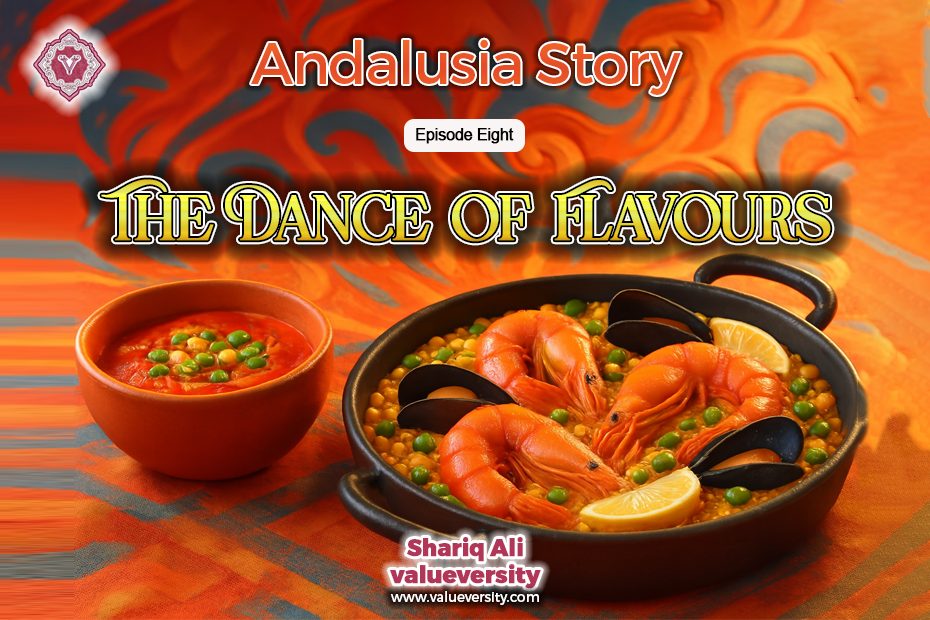The Dance of Flavours, Andalusia Chronicle – Episode 8
✍️ Shariq Ali
Valueversity
After wandering through the narrow alleys of old Córdoba, we emerged onto a well-lit street lined with vibrant restaurants, searching for the right place to dine. Even amidst this modern setting, the ancient walls of the Mosque of Córdoba seemed to walk alongside us, like a lingering fragrance from the past. Yet the view ahead was brimming with the colour and vitality of modern Spain.
We chose a Spanish restaurant decorated with colourful streamers hanging from the ceiling. While cheerful conversations echoed around the wooden tables outside, we preferred to sit in the central hall indoors. According to TripAdvisor, this place was well known for serving authentic local cuisine.
As we glanced through the menu, many of the names sounded entirely foreign:
Patatas Bravas, Gazpacho, Tortilla Española, and Paella.
All sounded exotic, rich with colour and aroma.
We settled on Paella — a saffron-infused rice dish filled with fish, prawns, vegetables, and fragrant spices. Alongside it, we ordered Patatas Bravas — fried potatoes served with a spicy sauce — and Gazpacho, a chilled tomato-based soup considered a Spanish specialty.
At the table beside us sat a middle-aged Spanish couple. Fortunately, both could speak English. After an exchange of smiles, they joined us at our table, and a conversation began. The woman’s name was Lorena, and the gentleman was Santiago. Lorena wore a colourful floral dress, with large dangling earrings that reflected her lively taste. Santiago held a guitar, and after a while, without warning, he softly began to hum — perhaps the prelude to a flamenco melody.
Despite the spontaneous singing, the atmosphere of the restaurant remained undisturbed. Music, conversation, and life flowed together in perfect harmony.
During the conversation, we learned that the people here live life like a song — a little sadness, a little joy, some mystical reflection, and a whole lot of passion.
Lorena remarked:
“We Spaniards are easygoing by nature. We live more in the moment than by the ticking of the clock. Our days start late, shops and markets don’t open before ten or eleven. Mealtimes are just as unstructured!”
I laughed and said, “That sounds just like us Pakistanis — random mealtimes and a good dose of laziness. We could definitely compete on those fronts!”
Santiago chuckled,
“Maybe that’s why we live longer — no rush, no stress. The average lifespan here is 83!”
From our chat, we picked up a few other interesting facts:
Spain is among the largest producers of olive oil in the world. The tradition of siesta — a rest after the afternoon meal — is still common in rural areas. Spaniards are considered some of the most sociable people in the world. Unlike other parts of Europe, dinner at 10 p.m. is completely normal here.
For them, flamenco is not just music or dance — it’s a cultural expression, a living emotion, a national narrative.
When it came to food, we found quite a similarity between biryani and paella — both being rice-based dishes cooked with meats and spices.
Paella, with its golden saffron rice, olive oil–sautéed seafood, prawns, and chicken — to me, it felt like a Spanish biryani.
The fried potatoes dipped in spicy sauce, along with the chilled tomato soup, created an explosion of flavour — it was as if a dance was taking place on the tongue. Salty, tangy, mildly sweet, and perfumed with the essence of olives — a true dance of flavours on the floor of the palate.
As the conversation turned to fashion, Lorena shared:
“On regular days, we prefer comfortable clothing. But on festivals, it’s like an explosion of colours. Even brands like Zara and Mango originate from Spain.”
When the food was served, Lorena smiled at us and said:
“Buen provecho!”
(Meaning, “Enjoy your meal!”)
We responded with a cheerful “Gracias.”
Truth be told, that one word is pretty much the full extent of our Spanish!
A vibrant, living Spanish culture — filled with hospitality, music, flavours, and colour!
(To be continued…)
